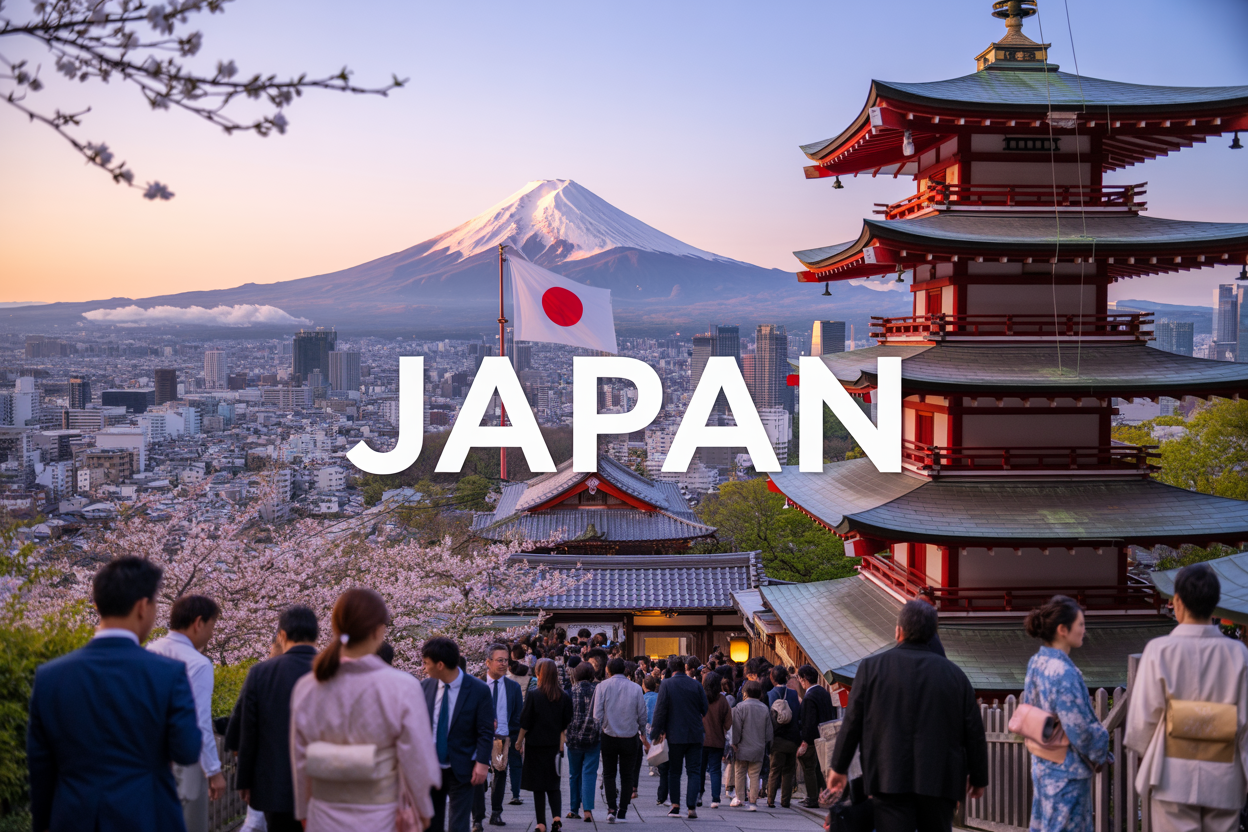
Japan stands as one of the world’s most fascinating countries, blending ancient traditions with cutting-edge technology in ways that captivate millions of visitors and culture enthusiasts worldwide. This comprehensive guide serves travelers, students, business professionals, and anyone curious about this remarkable island nation in East Asia.
You’ll discover Japan’s incredible transformation from isolated feudal society to global economic powerhouse, exploring how historical events shaped modern Japanese identity. We’ll dive deep into the country’s distinctive cultural heritage, from traditional arts like tea ceremony and kabuki to contemporary phenomena like anime and manga that influence pop culture globally. You’ll also get essential facts about Tokyo as the bustling capital city, Japan’s strategic geographic position, the meaningful symbolism behind its iconic flag, current population trends, and its impressive economic structure that makes it the world’s third-largest economy.
Get ready to explore a nation where ancient temples sit alongside gleaming skyscrapers, where respect for tradition coexists with innovation, and where every aspect of society reflects a unique blend of old and new.
Japan’s Rich Historical Journey Through the Ages
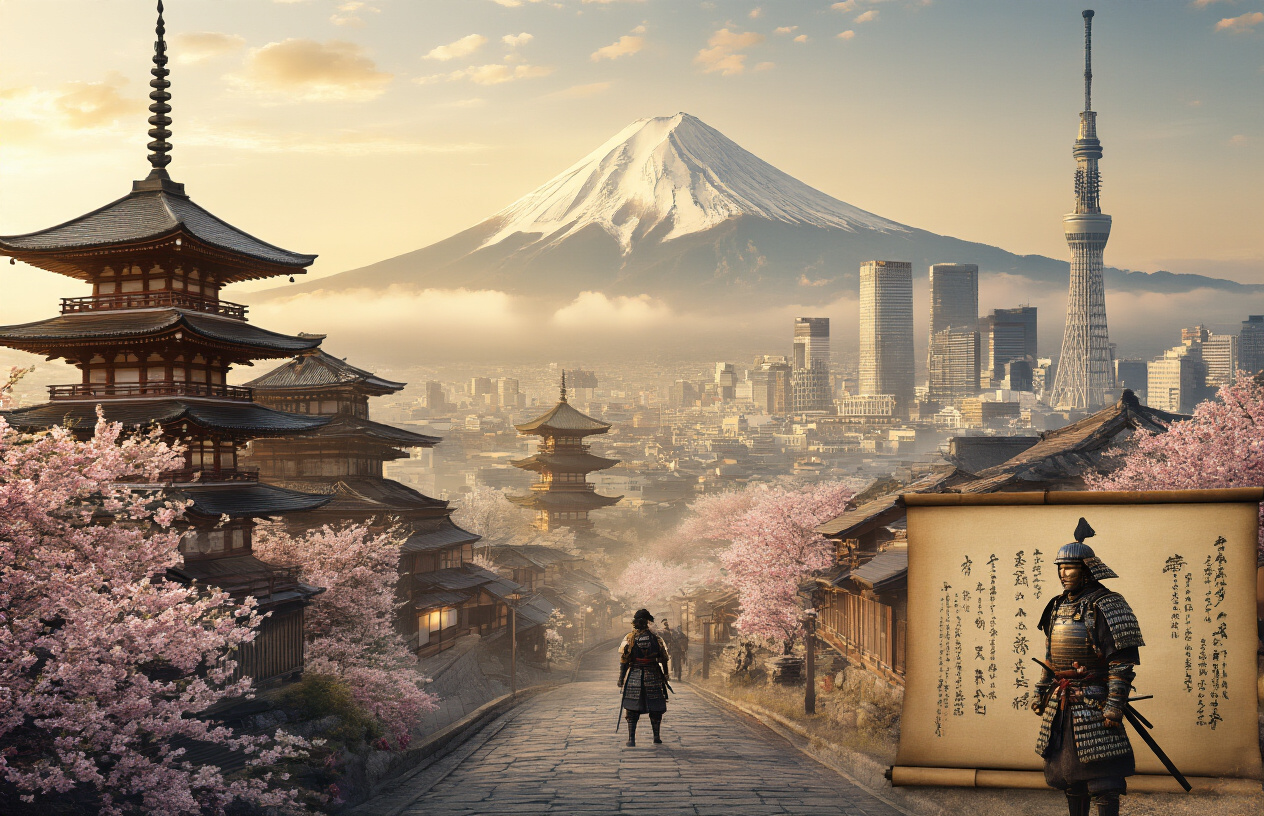
Ancient Origins and Early Civilizations
Japan’s story begins thousands of years ago with the mysterious Jomon people, who lived on the islands from around 14,000 BCE. These hunter-gatherers created some of the world’s earliest pottery, featuring intricate rope-like patterns that give the period its name. Their shell mounds and archaeological sites tell us about a sophisticated society that thrived on fishing, hunting, and gathering wild plants.
Around 300 BCE, the Yayoi period brought dramatic changes. Rice cultivation arrived from the Korean peninsula, transforming Japanese society from nomadic to agricultural. Bronze and iron tools replaced stone implements, and the first recognizable Japanese communities took shape. These early farmers built raised-floor buildings and developed complex irrigation systems that would become the foundation of Japanese civilization.
The Kofun period (300-538 CE) marked Japan’s emergence as a more unified society. Massive burial mounds, some larger than Egyptian pyramids, housed powerful rulers who controlled vast territories. During this time, Chinese writing systems, Buddhism, and Confucianism began filtering into Japan through Korean kingdoms, laying the groundwork for Japan’s unique blend of indigenous and foreign influences.
Feudal Era and Rise of the Samurai Class
The Heian period (794-1185) saw the birth of a distinctly Japanese aristocratic culture, but it also witnessed the gradual decline of imperial power. As court nobles focused on poetry and aesthetics, provincial warrior families grew stronger. The Taira and Minamoto clans emerged as the dominant military forces, setting the stage for centuries of warrior rule.
Minamoto Yoritomo’s victory at the Battle of Dan-no-ura in 1185 established the Kamakura shogunate, Japan’s first military government. The samurai class became the ruling elite, following the bushido code that emphasized loyalty, honor, and martial prowess. These warriors weren’t just fighters – they were administrators, poets, and patrons of the arts.
The Muromachi period brought both cultural flowering and constant warfare. Zen Buddhism profoundly influenced samurai culture, while the Onin War (1467-1477) plunged Japan into a century of conflict known as the Sengoku period. Regional warlords called daimyo carved up the country into competing domains, each maintaining armies of samurai retainers.
Oda Nobunaga began the reunification process in the late 16th century, using innovative military tactics and European firearms. Toyotomi Hideyoshi continued this work, implementing social reforms that clearly separated samurai from other classes. Tokugawa Ieyasu’s victory at Sekigahara in 1600 finally brought peace and established the longest-lasting military government in Japanese history.
Isolation Period and Sakoku Policy Impact
The Tokugawa shogunate implemented sakoku (closed country) policies starting in the 1630s, severely limiting foreign contact for over two centuries. This wasn’t just xenophobia – it was a calculated strategy to maintain political stability and prevent foreign interference. Only Dutch and Chinese traders could operate from the tiny artificial island of Dejima in Nagasaki harbor.
During this isolation, Japan developed a unique internal culture. The merchant class grew wealthy and influential despite official social hierarchies that placed them at the bottom. Cities like Edo (Tokyo), Osaka, and Kyoto became vibrant centers of commerce and culture. The floating world (ukiyo) culture emerged, celebrating pleasure quarters, kabuki theater, and woodblock prints that would later captivate European artists.
Education flourished under the Tokugawa. Terakoya (temple schools) taught basic literacy to common people, while domain schools educated samurai children. By 1850, Japan had one of the world’s highest literacy rates. This educational foundation would prove crucial for rapid modernization.
The rigid class system began showing cracks by the 19th century. Merchants accumulated wealth while samurai faced financial hardship. Rural uprisings became more frequent as economic pressures mounted. Western nations increasingly pressured Japan to open its ports, culminating in Commodore Perry’s arrival in 1853 with his “Black Ships.”
Meiji Restoration and Rapid Modernization
The arrival of American warships in 1853 exposed Japan’s military weakness and forced the country to sign unequal treaties. These humiliating agreements sparked a movement to “revere the emperor, expel the barbarians.” Young samurai from domains like Satsuma and Choshu overthrew the Tokugawa government in 1868, restoring imperial rule under Emperor Meiji.
The new government launched an unprecedented transformation campaign called fukoku kyohei (rich country, strong military). They abolished the feudal system, eliminated samurai privileges, and created a modern conscript army. The Meiji leaders studied Western institutions intensively, adopting German constitutional monarchy, British naval technology, French legal codes, and American educational systems.
Japan’s modernization happened at breakneck speed. The government built railroads, telegraph lines, and modern factories. They invited thousands of foreign experts while sending Japanese students abroad to master Western knowledge. Traditional Japanese clothing gave way to Western dress in official settings, and the calendar changed from lunar to solar.
The transformation wasn’t without resistance. The Satsuma Rebellion in 1877 saw traditional samurai fight desperately against the new conscript army. Their defeat symbolized the complete triumph of modernization over tradition. By the 1890s, Japan had a constitution, parliament, and modern military that could challenge Western powers. This rapid transformation from isolated feudal society to modern industrial nation remains one of history’s most remarkable achievements.
Understanding Japan’s Unique Cultural Heritage
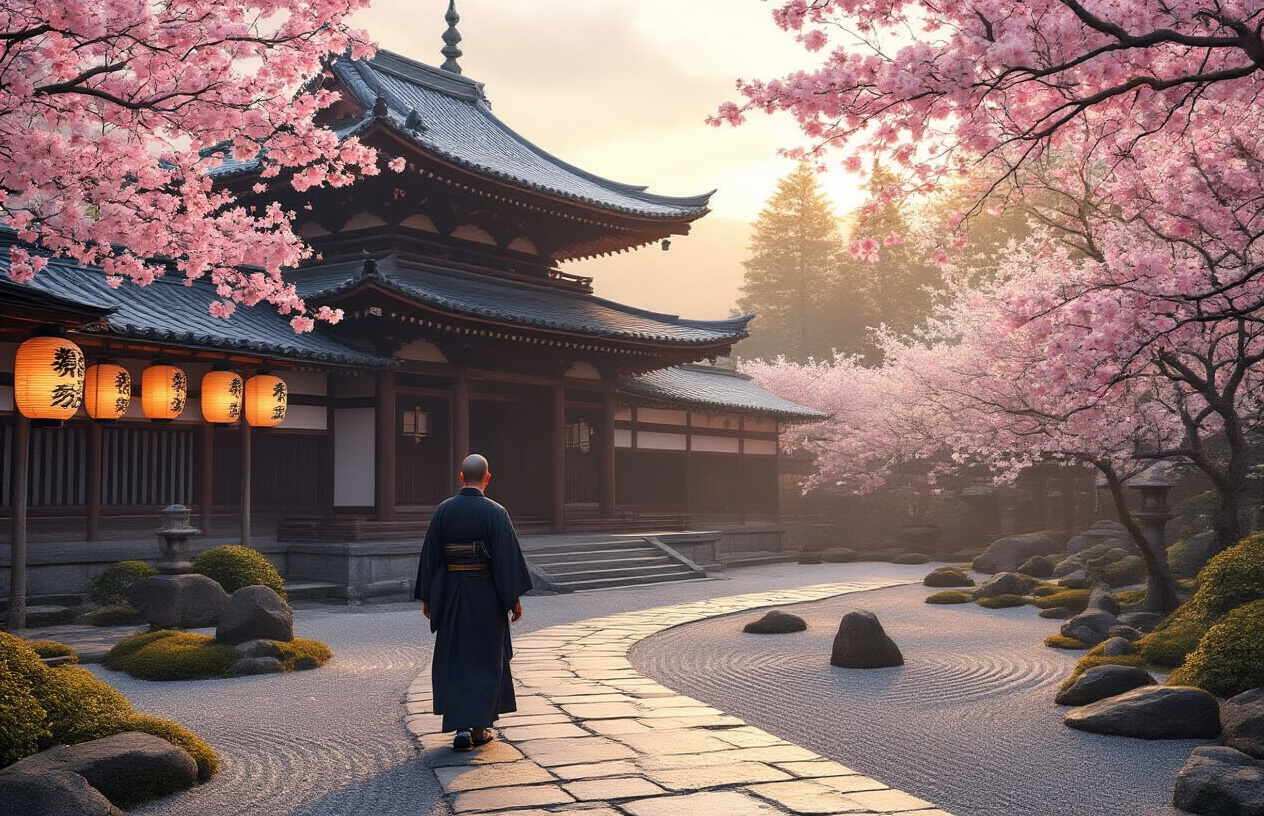
Traditional Arts and Crafts Preservation
Japan has managed to keep its traditional arts alive in ways that would make other countries envious. Take tea ceremony, for example – this isn’t just about making tea. The whole ritual represents harmony, respect, purity, and tranquility. Every movement has meaning, from how you hold the bowl to the way you whisk the matcha.
Origami transforms simple paper into incredible sculptures without using scissors or glue. What started as a way to wrap gifts has become a sophisticated art form that teaches patience and precision. Master folders can create incredibly detailed dragons, flowers, and geometric patterns that seem impossible.
The art of Japanese sword-making, or katana forging, continues today with living national treasures who spend years perfecting their craft. These artisans heat, fold, and hammer steel thousands of times to create blades that are both beautiful and functional. The process can take months for a single sword.
Pottery traditions like Raku and Kintsugi show Japan’s unique philosophy toward imperfection. Kintsugi repairs broken ceramics with gold, making the damage part of the object’s beauty rather than hiding it. This reflects the Japanese concept of finding beauty in flaws and impermanence.
Kabuki theater combines drama, music, and dance in elaborate performances where actors wear striking makeup and costumes. Male actors traditionally play all roles, including female characters, requiring years of training to master the stylized movements and vocal techniques.
Modern Pop Culture Global Influence
Japanese pop culture has taken over the world in ways no one saw coming. Anime started as children’s cartoons in Japan but now fills streaming platforms globally. Shows like “Attack on Titan” and “Demon Slayer” have massive international followings, with fans learning Japanese just to watch episodes without subtitles.
Manga sells millions of copies worldwide, influencing comic book styles from America to France. The visual storytelling techniques developed in manga have shaped how graphic novels approach pacing and emotional expression. Publishers now release simultaneous international editions to meet global demand.
J-pop groups like BTS’s Japanese counterparts have created dedicated fanbases across continents. The idol culture, with its emphasis on perfection and fan interaction, has inspired similar movements in other countries. Concert tours regularly sell out venues from Los Angeles to London.
Video games represent Japan’s biggest cultural export. Nintendo, Sony, and companies like Capcom and Square Enix have defined gaming for generations. Characters like Mario, Pikachu, and Sonic are recognized worldwide, transcending language barriers.
Fashion trends from Harajuku street style to minimalist Japanese design influence runways in Paris and New York. Japanese designers like Yohji Yamamoto and Comme des Garçons have revolutionized fashion with their avant-garde approaches.
Cosplay culture, where fans dress as fictional characters, originated in Japan and now dominates conventions worldwide. This has created entire industries around costume design and character representation.
Religious Practices and Spiritual Beliefs
Most Japanese people practice a blend of Shintoism and Buddhism without seeing any contradiction. Shintoism focuses on kami, spirits that inhabit natural objects like trees, rocks, and mountains. These aren’t gods in the Western sense but rather spiritual essences that deserve respect and offerings.
Buddhist temples and Shinto shrines often sit side by side, sometimes even sharing the same grounds. People might pray at a Shinto shrine for good luck in business, then visit a Buddhist temple to honor deceased relatives. This mixing of traditions feels natural to most Japanese people.
Seasonal festivals connect spiritual beliefs to daily life. Cherry blossom season brings hanami parties where families gather under blooming trees, celebrating the temporary beauty of life. The Obon festival honors ancestors, with families cleaning graves and lighting lanterns to guide spirits home.
Many homes have both Shinto shelves called kamidana and Buddhist altars called butsudan. Daily offerings of rice, water, and incense maintain connections to both spiritual traditions and family ancestors.
Zen Buddhism has influenced everything from garden design to martial arts. The emphasis on mindfulness and simplicity appears in activities like flower arranging, archery, and even business practices. Meditation isn’t seen as religious but as mental training.
Modern Japanese spirituality often includes new religious movements and personal spiritual practices. Many people find meaning in traditional rituals while adapting them to contemporary life, creating a uniquely Japanese approach to faith that emphasizes harmony over dogma.
Tokyo as Japan’s Dynamic Capital City
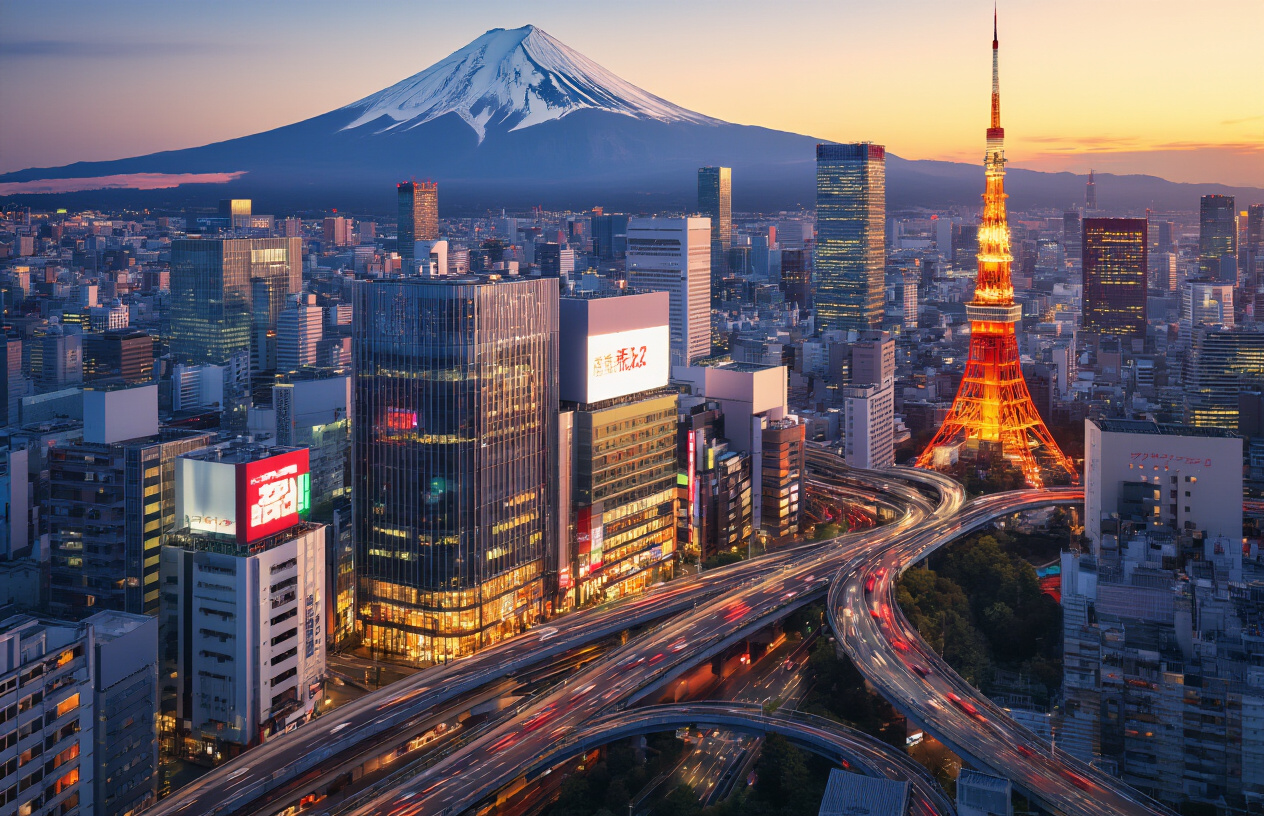
Political Center and Government Functions
Tokyo serves as the political heart of Japan, housing the country’s most important governmental institutions within its boundaries. The Imperial Palace sits at the city’s center, symbolizing the continuity of Japan’s constitutional monarchy. The Diet Building, Japan’s bicameral legislature, stands prominently in the Nagatacho district, where major political decisions shape the nation’s future.
The Prime Minister’s residence and various ministry headquarters cluster throughout central Tokyo, creating a concentrated hub of administrative power. Key districts like Kasumigaseki contain numerous government offices, while diplomatic missions from around the world establish their embassies in areas such as Roppongi and Akasaka. This concentration allows for efficient coordination between different branches of government and international partners.
Economic Hub and Business District Overview
Tokyo’s status as Japan’s economic powerhouse becomes evident through its numerous business districts, each serving distinct commercial purposes. Marunouchi stands as the traditional financial center, housing major banks, insurance companies, and corporate headquarters in gleaming skyscrapers. The Tokyo Stock Exchange, one of the world’s largest financial markets, operates from this district.
Shibuya represents modern consumer culture and technology, while Ginza showcases luxury retail and high-end commerce. The broader Tokyo metropolitan area contributes approximately one-third of Japan’s total GDP, making it one of the world’s most economically productive urban regions.
| District | Primary Function | Notable Features |
|---|---|---|
| Marunouchi | Finance & Corporate | Tokyo Station, Major banks |
| Shibuya | Technology & Retail | Shibuya Crossing, Tech companies |
| Ginza | Luxury Shopping | High-end boutiques, Department stores |
| Shinjuku | Mixed Business | Government offices, Entertainment |
Cultural Attractions and Tourist Destinations
Tokyo blends ancient traditions with cutting-edge modernity, creating an unparalleled cultural landscape. Traditional temples like Senso-ji in Asakusa offer glimpses into Japan’s spiritual heritage, while nearby districts showcase contemporary art and pop culture phenomena.
The city’s museums rank among the world’s finest, including the Tokyo National Museum, which houses the world’s largest collection of Japanese art. Modern attractions like Tokyo Skytree and the rebuilt Tokyo Tower provide spectacular city views, while themed districts such as Harajuku display Japan’s unique fashion subcultures.
Popular cultural destinations include:
- Traditional Sites: Meiji Shrine, Imperial East Gardens, Senso-ji Temple
- Modern Attractions: Tokyo Skytree, teamLab digital art museums, Robot Restaurant
- Cultural Districts: Shibuya for youth culture, Ginza for sophistication, Akihabara for electronics and anime
- Entertainment: Kabuki theaters, sumo wrestling at Ryogoku, numerous festivals throughout the year
Urban Development and Infrastructure Excellence
Tokyo demonstrates remarkable urban planning and infrastructure development, particularly evident in its world-renowned transportation system. The city’s extensive rail network, including JR lines, private railways, and subway systems, efficiently moves millions of passengers daily with exceptional punctuality and reliability.
The urban landscape showcases innovative architectural solutions to space constraints, with mixed-use developments maximizing limited land area. Smart city initiatives integrate technology into daily life, from automated convenience stores to digital signage systems that adapt to real-time conditions.
Recent infrastructure projects prepare Tokyo for future challenges, including earthquake-resistant buildings, flood management systems, and sustainable energy initiatives. The city’s commitment to environmental sustainability shows through green building standards, urban parks, and waste management systems that achieve remarkable recycling rates exceeding 20% citywide.
Transportation infrastructure includes multiple international airports, extensive highway networks, and port facilities that connect Tokyo to global markets. The upcoming Linear Chuo Shinkansen project will reduce travel time to other major cities, strengthening Tokyo’s position as Japan’s central hub.
Geographic Location and Territorial Boundaries
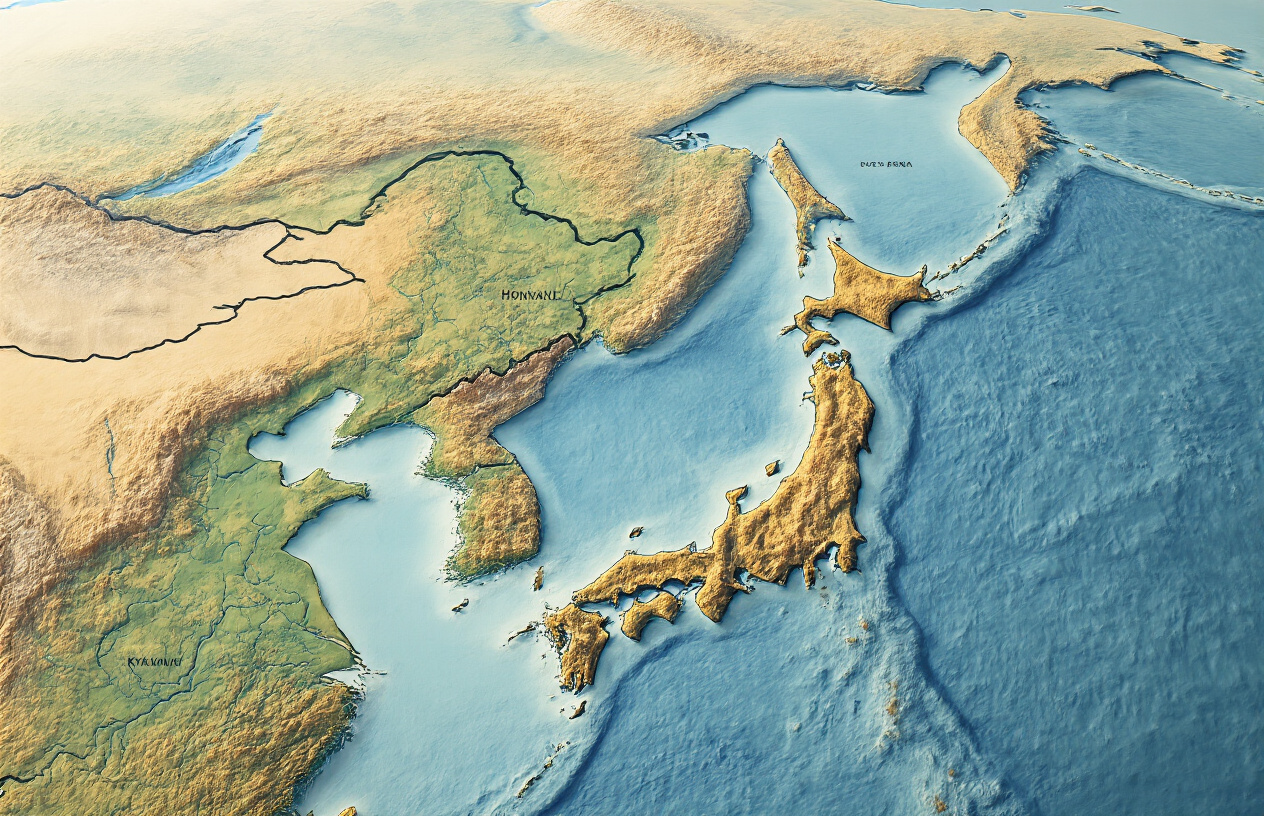
Island Nation Composition and Layout
Japan consists of four main islands that stretch across approximately 3,000 kilometers from northeast to southwest in the Pacific Ocean. The largest and most populous island, Honshu, houses about 80% of Japan’s population and contains major urban centers including Tokyo, Osaka, and Kyoto. Hokkaido, the northernmost island, offers vast wilderness areas and agricultural lands, while Kyushu in the south serves as a gateway to Asia with its volcanic landscapes and hot springs. Shikoku, the smallest of the four main islands, maintains a more traditional rural character with ancient pilgrimage routes crossing its mountainous terrain.
Beyond these primary landmasses, Japan encompasses over 6,800 smaller islands, though only about 430 are inhabited. The Ryukyu Islands extend southwest toward Taiwan, with Okinawa being the most significant. The Ogasawara Islands lie roughly 1,000 kilometers south of Tokyo, while the disputed Northern Territories remain a point of contention with Russia. This archipelago configuration creates distinct regional climates and ecosystems, from the subarctic conditions of northern Hokkaido to the subtropical environments of southern Okinawa.
The total land area covers approximately 377,975 square kilometers, making Japan slightly smaller than California but with a population nearly four times larger. The country’s elongated shape and mountainous terrain have historically influenced settlement patterns, transportation networks, and regional cultural development.
Major Cities and Regional Divisions
Japan’s administrative structure divides the nation into 47 prefectures, each with distinct characteristics and governance. The Greater Tokyo Area stands as the world’s most populous metropolitan region, encompassing Tokyo and surrounding prefectures with over 37 million residents. This massive urban sprawl includes satellite cities like Yokohama, Kawasaki, and Chiba, creating a continuous metropolitan landscape.
The Kansai region centers around Osaka and includes the ancient capitals of Kyoto and Nara, serving as Japan’s cultural and historical heartland. Osaka functions as a major commercial hub, while Kyoto preserves thousands of temples and traditional architecture. Other significant urban centers include Nagoya in central Japan, known for automotive manufacturing, and Sapporo in Hokkaido, famous for its winter festivals and beer production.
| Region | Major Cities | Population (millions) | Key Industries |
|---|---|---|---|
| Kanto | Tokyo, Yokohama, Kawasaki | 43.3 | Finance, technology, manufacturing |
| Kansai | Osaka, Kyoto, Kobe | 22.4 | Commerce, culture, heavy industry |
| Chubu | Nagoya, Shizuoka | 21.7 | Automotive, textiles |
| Kyushu | Fukuoka, Kumamoto | 12.9 | Agriculture, electronics |
| Tohoku | Sendai | 8.8 | Agriculture, fishing |
Regional divisions reflect historical domains and natural geographic boundaries, with each area maintaining unique dialects, culinary traditions, and cultural practices that contribute to Japan’s rich diversity.
Natural Landmarks and Geographic Features
Japan sits along the Pacific Ring of Fire, creating a dramatic landscape dominated by volcanic activity and mountainous terrain. Mount Fuji, standing at 3,776 meters, represents Japan’s most iconic natural landmark and holds deep spiritual significance in Japanese culture. This active volcano last erupted in 1707 and attracts millions of visitors annually who come to climb its slopes or admire its perfect conical shape.
The Japanese Alps traverse central Honshu, creating three distinct mountain ranges that offer spectacular hiking, skiing, and hot spring experiences. These peaks rise above 3,000 meters and experience heavy snowfall, supporting a thriving winter sports industry. The country’s mountainous nature means that only about 20% of the land is suitable for agriculture and urban development, concentrating population along coastal plains and river valleys.
Japan’s extensive coastline stretches over 29,700 kilometers, featuring everything from dramatic cliff faces to gentle sandy beaches. The Inland Sea between Honshu, Shikoku, and Kyushu contains over 700 islands and provides calm waters for transportation and fishing. Major rivers include the Shinano, Japan’s longest at 367 kilometers, and the Tone, which flows through the Tokyo metropolitan area.
The country experiences frequent seismic activity with over 1,500 earthquakes recorded annually, though most are minor. Active volcanoes number around 110, with Mount Aso in Kyushu featuring one of the world’s largest volcanic calderas. These geological forces have shaped Japan’s landscape over millions of years, creating unique formations like the columnar basalt cliffs of the Izu Peninsula and the limestone caves of Akiyoshi-dai Plateau.
National Symbols and Flag Significance
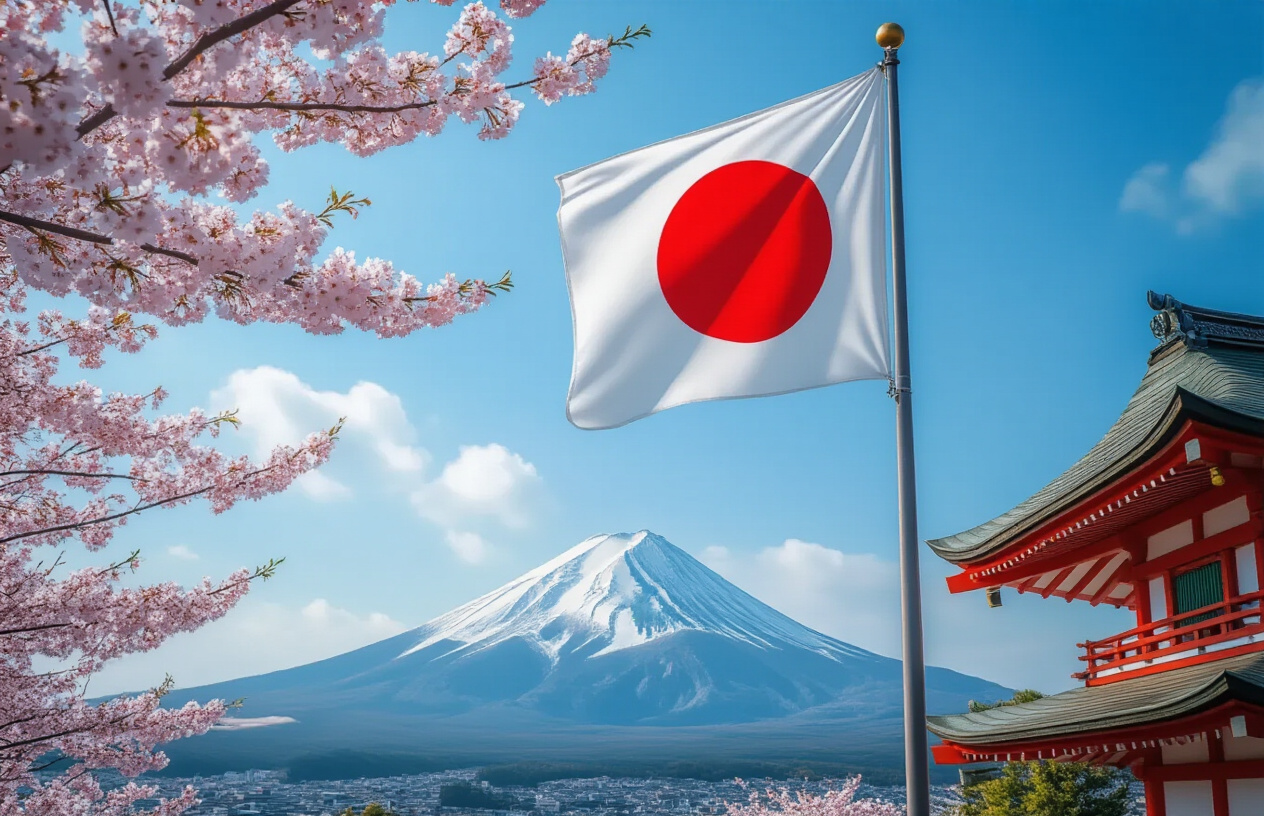
Rising Sun Design History and Meaning
Japan’s national flag features a simple yet powerful design: a red circle centered on a white field. This red disc represents the sun, earning the flag its common name “Hinomaru,” which translates to “circle of the sun.” The symbolism runs deep in Japanese culture, as Japan has long been known as the “Land of the Rising Sun.”
The flag’s origins trace back to ancient Japanese mythology, where the sun goddess Amaterasu holds supreme importance in Shinto beliefs. Historical records show variations of sun symbols appearing on Japanese banners as early as the 12th century during the Kamakura period. Samurai warriors carried flags bearing sun motifs into battle, believing they carried divine protection.
The modern flag design gained official recognition during the mid-19th century when Japan began opening to Western influence. The Meiji government formally adopted the current specifications in 1870, establishing the precise proportions and color standards still used today. The red circle occupies exactly 3/5 of the flag’s height and sits perfectly centered on the white background.
The color choices carry specific meaning beyond their solar symbolism. Red represents honesty, sincerity, and the warmth of human emotion, while white symbolizes purity, righteousness, and the nation’s peaceful intentions. These colors appear throughout Japanese art, architecture, and ceremonial objects, reinforcing their cultural significance.
Cultural Importance in Japanese Society
The Hinomaru holds profound cultural significance that extends far beyond its role as a national symbol. Japanese people view the flag as embodying core values like harmony, respect, and national unity. During traditional festivals and ceremonies, the flag’s presence serves as a reminder of shared heritage and collective identity.
School ceremonies provide prime examples of the flag’s cultural integration. Students participate in flag-raising ceremonies at the beginning of each school year, learning proper respect and understanding of national symbols. These practices help instill civic pride and cultural awareness from an early age.
Sports events showcase another dimension of the flag’s cultural importance. Japanese athletes competing internationally carry the flag with immense pride, and spectators wave smaller versions to show support. The sight of the Hinomaru rising during Olympic victory ceremonies creates powerful emotional moments that unite the entire nation.
The flag also appears prominently during national holidays, particularly National Foundation Day in February and the Emperor’s Birthday. Households and businesses display the flag to demonstrate patriotism and participation in national celebrations. This widespread civilian use reflects the flag’s deep integration into everyday Japanese life.
Religious and spiritual contexts further emphasize the flag’s cultural weight. Many Shinto shrines incorporate sun symbolism in their architecture and ceremonies, creating natural connections with the national flag. The shared solar imagery reinforces the flag’s legitimacy as a true representation of Japanese spiritual values.
Official Protocol and Display Guidelines
Japan maintains specific protocols governing proper flag display and handling. The Flag and Anthem Law of 1999 established official guidelines that government institutions, schools, and public organizations must follow. These rules ensure consistent and respectful treatment of national symbols.
Government buildings display the flag daily from sunrise to sunset, following precise positioning requirements. The flag must fly freely without touching the ground or other objects, and weather conditions determine appropriate display times. During inclement weather, flags are typically lowered to prevent damage.
Ceremonial occasions require heightened attention to flag protocol. State visits, diplomatic meetings, and official ceremonies follow strict placement rules. When displayed alongside foreign flags, the Japanese flag receives equal treatment in terms of size and positioning, reflecting principles of mutual respect in international relations.
Educational institutions follow specific guidelines during school events. The flag appears at graduation ceremonies, entrance ceremonies, and sports festivals, accompanied by the singing of the national anthem. Teachers receive training on proper flag handling and storage procedures to maintain appropriate respect.
Private citizens enjoy considerable freedom in flag display, though cultural expectations encourage respectful treatment. Homes and businesses commonly display smaller versions during national holidays, following general guidelines about proper positioning and care. Commercial use requires sensitivity to avoid inappropriate associations or disrespectful contexts.
Proper flag disposal follows traditional Japanese practices emphasizing respect and dignity. Worn flags cannot simply be discarded; instead, they should be retired through burning in a respectful ceremony or returned to appropriate authorities for proper handling.
Demographics and Population Characteristics
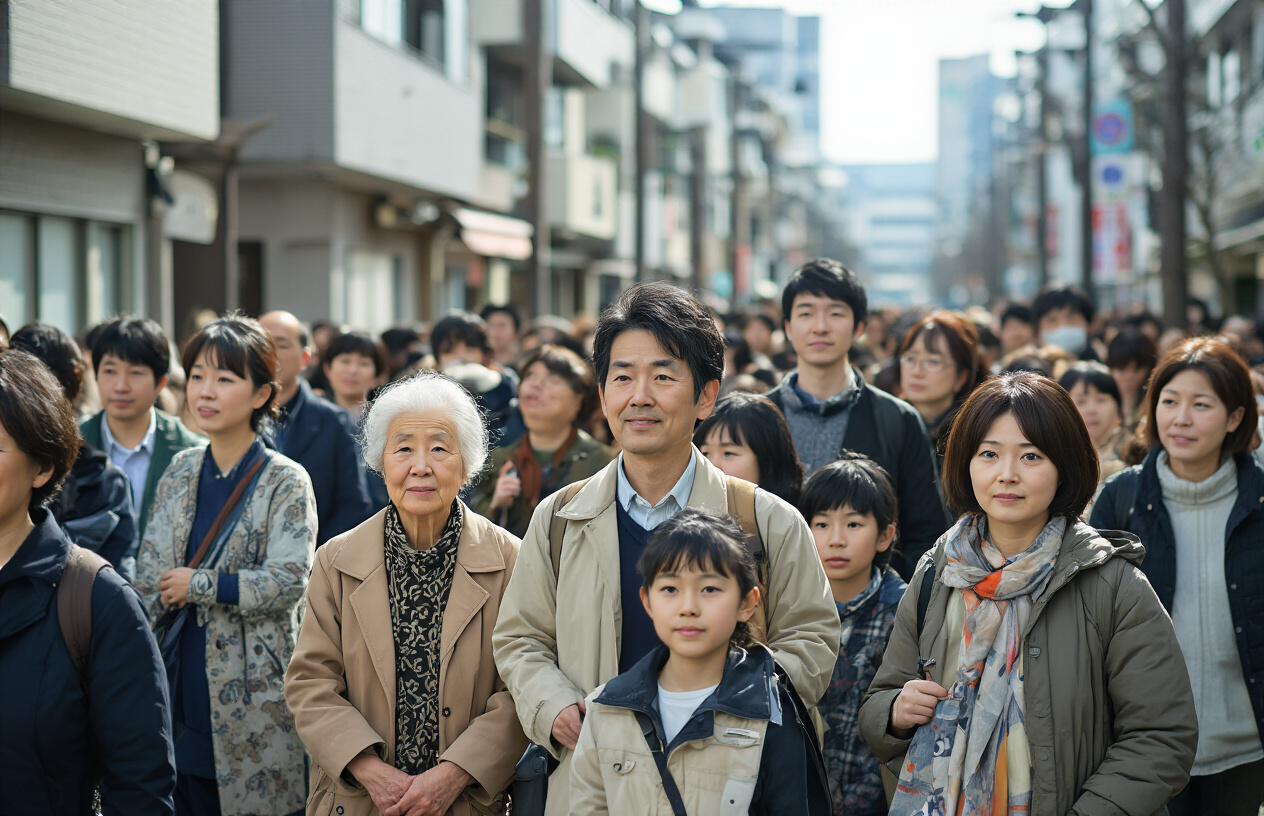
Current Population Statistics and Trends
Japan’s population stands at approximately 124.8 million people as of 2024, making it the world’s tenth most populous country. The nation has experienced a significant demographic shift over the past decade, with the population declining by roughly 0.3-0.7% annually since reaching its peak of 128 million in 2008. This decline represents one of the most notable demographic transitions among developed nations.
Birth rates have plummeted to historic lows, with the total fertility rate hovering around 1.3 children per woman – well below the replacement level of 2.1. Deaths now outnumber births by approximately 600,000 annually, creating a natural population decrease that demographic experts predict will continue for decades. The Japanese government projects the population could drop to around 88 million by 2065 if current trends persist.
Life expectancy remains among the world’s highest, with Japanese women living an average of 87.1 years and men 81.1 years. This longevity, combined with declining birth rates, creates a rapidly aging society that poses unique challenges for social services, healthcare systems, and economic planning.
Age Distribution and Demographic Challenges
Japan’s age pyramid has dramatically inverted over recent decades, creating what demographers call a “super-aged society.” People aged 65 and older now comprise approximately 29.1% of the total population – the highest percentage globally. This group numbers around 36 million individuals, with projections suggesting it could reach 38% by 2065.
The working-age population (15-64 years) has shrunk to about 59% of the total, down from over 70% in the 1990s. This shrinking workforce creates immense pressure on social security systems, with fewer workers supporting each retiree. The dependency ratio – the number of dependents per 100 working-age people – continues climbing, straining pension funds and healthcare resources.
Children under 15 represent just 11.9% of the population, the lowest proportion in Japanese history. This demographic bottleneck means fewer future workers, taxpayers, and consumers, creating long-term economic challenges. Rural areas face particularly acute aging, with some villages reporting over 50% of residents being seniors.
The phenomenon of “kodokushi” (lonely deaths) has become increasingly common as elderly people live alone without family support. Care facilities struggle to meet demand, while the traditional family caregiving model breaks down under modern economic pressures.
Urbanization Patterns and City Growth
Japan ranks among the world’s most urbanized countries, with approximately 91.8% of the population living in urban areas. This concentration reflects decades of rural-to-urban migration that accelerated during the post-war economic boom. The Greater Tokyo Area alone houses about 37 million people, making it the world’s largest metropolitan area by population.
The urban landscape is dominated by several major population centers:
- Greater Tokyo Area: 37+ million residents across Tokyo, Kanagawa, Saitama, and Chiba
- Kansai Region: 19+ million people around Osaka, Kyoto, and Kobe
- Nagoya Metropolitan Area: 10+ million residents
- Fukuoka-Kitakyushu: 2.4+ million people
Rural depopulation has created “ghost towns” and abandoned villages, particularly in mountainous regions. Young people migrate to cities for education and employment opportunities, leaving behind aging rural communities. Some rural areas have lost over 30% of their population since 1990, creating challenges for maintaining infrastructure, schools, and local services.
Urban areas face different pressures, including housing shortages, congestion, and high living costs. Tokyo’s housing prices remain among the world’s highest, pushing many residents to lengthy commutes from suburban areas. The government has implemented various policies to encourage regional development and stem rural population loss, but urban concentration continues.
Despite urbanization challenges, Japanese cities maintain relatively high livability standards, with efficient public transportation, low crime rates, and extensive urban planning that balances development with green spaces.
Economic Structure and Global Position
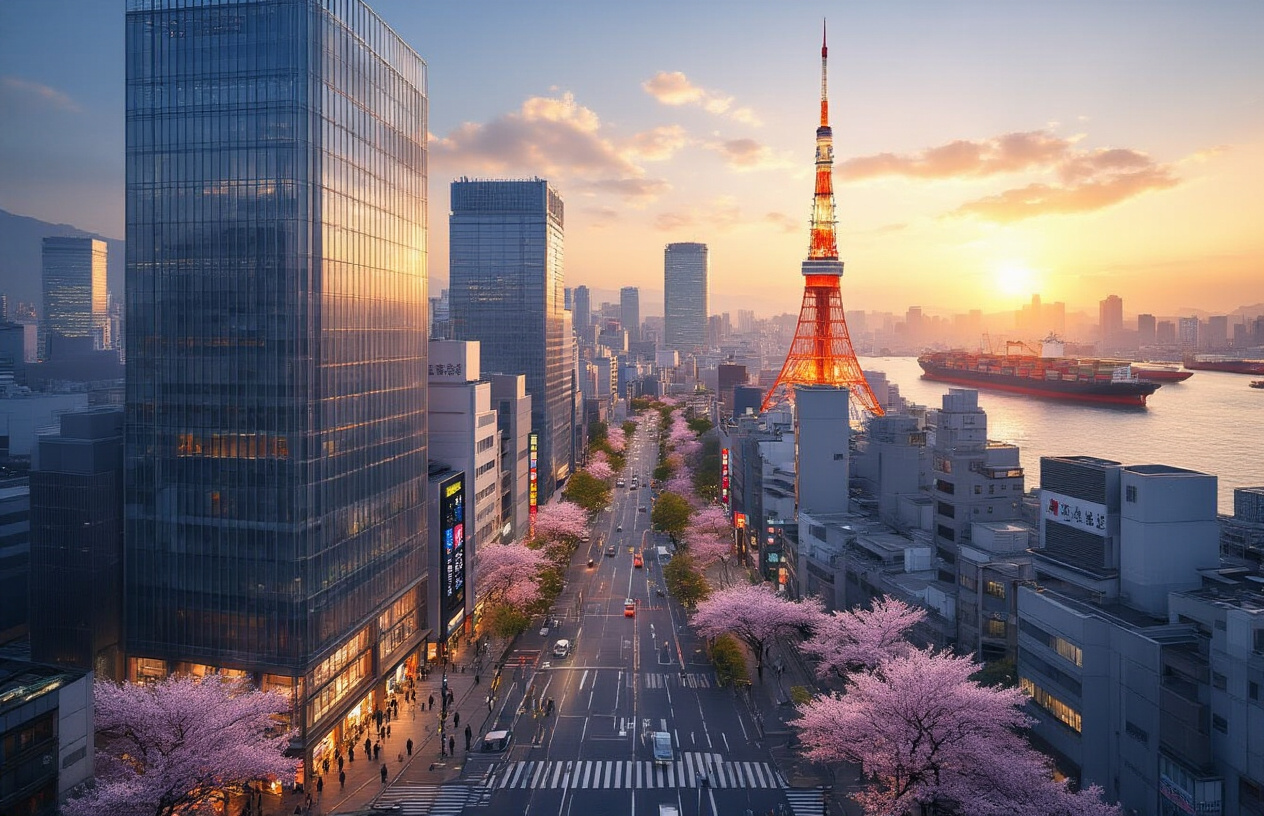
Major Industries and Manufacturing Sectors
Japan’s economy rests on several powerhouse industries that have shaped its global reputation. The automotive sector stands as a crown jewel, with Toyota, Honda, Nissan, and Mazda producing millions of vehicles annually for both domestic and international markets. These companies didn’t just build cars – they revolutionized manufacturing through lean production methods that other industries worldwide now adopt.
Electronics and semiconductor manufacturing form another cornerstone of Japan’s industrial landscape. Sony, Panasonic, Nintendo, and Sharp have become household names globally, while companies like TSMC Japan and Renesas lead in semiconductor production. The precision machinery sector produces everything from industrial robots to high-speed trains, with Japanese bullet trains representing the pinnacle of rail technology.
Steel production remains vital, with companies like Nippon Steel and JFE Holdings ranking among the world’s largest producers. The chemical industry contributes significantly through companies like Mitsubishi Chemical and Sumitomo Chemical, producing materials essential for various manufacturing processes.
Shipbuilding represents a traditional strength, with Japanese shipyards constructing massive cargo vessels and specialized ships. The textile industry, while smaller than in previous decades, continues producing high-quality fabrics and technical textiles for specialized applications.
International Trade Relationships and Partnerships
Japan actively participates in numerous trade agreements that strengthen its economic position. The Comprehensive and Progressive Agreement for Trans-Pacific Partnership (CPTPP) connects Japan with 10 other Pacific nations, creating opportunities for expanded trade and investment flows.
China represents Japan’s largest trading partner, despite occasional political tensions. Bilateral trade encompasses everything from Japanese automotive exports to Chinese electronics and raw materials flowing into Japan. The relationship remains economically crucial for both nations.
The United States maintains a strong trade partnership with Japan, particularly in automotive, technology, and agricultural sectors. American soybeans, beef, and technology products enter Japanese markets, while Japanese cars, electronics, and machinery flow to American consumers.
South Korea and Japan engage in significant trade despite periodic diplomatic challenges. Technology components, chemicals, and machinery form the backbone of this relationship. Southeast Asian nations provide Japan with raw materials and serve as manufacturing bases for Japanese companies.
The European Union represents another major trading bloc, with Germany being Japan’s primary European partner. Japanese companies have established significant manufacturing presence in European markets, particularly in automotive and electronics sectors.
Technology Innovation and Research Development
Japan invests heavily in research and development, consistently ranking among the top nations for R&D spending as a percentage of GDP. This commitment drives innovation across multiple technological frontiers, from artificial intelligence to robotics and renewable energy.
Robotics represents a particular area of excellence, with Japan leading in both industrial and service robots. Companies like Fanuc, Kawasaki Heavy Industries, and SoftBank Robotics push boundaries in automation, humanoid robots, and AI-powered systems. Japanese factories extensively use robots, creating a model that other countries study and emulate.
Artificial intelligence and machine learning research flourishes in Japanese universities and corporate labs. RIKEN, Japan’s largest research institute, conducts groundbreaking work in quantum computing and AI applications. Tech giants like NTT and Fujitsu develop advanced computing systems and telecommunications infrastructure.
Biotechnology and pharmaceutical research receive substantial investment, with companies like Takeda, Astellas, and Daiichi Sankyo developing innovative treatments. Japan’s aging population drives particular focus on medical technology and healthcare innovations.
Renewable energy technology development accelerates as Japan seeks energy independence. Solar panel efficiency improvements, hydrogen fuel cells, and offshore wind technology represent key research areas. The government’s carbon neutrality goals by 2050 intensify these efforts.
Financial Markets and Banking System
The Tokyo Stock Exchange ranks as one of the world’s largest financial markets, hosting over 3,700 listed companies and facilitating trillions of dollars in daily trading volume. The Nikkei 225 index serves as a key benchmark for Japanese equities and influences global market sentiment.
Japan’s banking system centers around several major institutions that wield considerable influence both domestically and internationally. Mitsubishi UFJ Financial Group, Sumitomo Mitsui Financial Group, and Mizuho Financial Group form the core of Japanese banking, providing corporate financing, retail banking, and investment services across Asia and beyond.
The Bank of Japan maintains monetary policy through interest rate decisions and quantitative easing measures. Ultra-low interest rates, maintained for over two decades, aim to stimulate economic growth and combat deflation. This policy creates unique challenges and opportunities for both consumers and businesses.
Corporate financing relies heavily on bank lending rather than capital markets, though this balance is gradually shifting. Japanese companies traditionally maintain close relationships with their main banks, receiving not just financing but strategic guidance and support during difficult periods.
Government bonds play a crucial role in Japan’s financial system, with the domestic market being one of the world’s largest. The high level of government debt creates ongoing discussions about fiscal sustainability, though domestic ownership of most debt provides stability.
Fintech innovation grows rapidly, with mobile payments, cryptocurrency trading, and digital banking services expanding. Companies like Rakuten and SoftBank drive financial technology adoption, while traditional banks invest heavily in digital transformation to remain competitive.

Japan stands as a remarkable blend of ancient traditions and modern innovation, where centuries of rich history have shaped one of the world’s most distinctive cultures. From the bustling streets of Tokyo to the geographic beauty of its island nation, Japan offers a fascinating study of how a country can honor its past while embracing the future. The significance of its national symbols, diverse population, and strong cultural values creates a unique identity that sets Japan apart on the global stage.
The country’s economic powerhouse status combined with its cultural depth makes Japan an influential player in international affairs. Understanding Japan’s journey through history, its vibrant capital, geographic significance, and demographic characteristics provides valuable insight into how this island nation continues to thrive. For anyone interested in exploring world cultures or understanding global economics, Japan serves as an excellent example of how tradition and progress can coexist successfully.